|
Local Tours
Time: 9.00 am to 1.00 pm. Visit City Palace & Jantar Mantar (observatory), Albert Hall Museum , Ram Niwas Gardens; drive past Hawa Mahal / the Palace of Winds & through the pink rose residential/business areas of Jaipur. and Drop at your hotel in the afternoon.
Half Day City Tour Tour through the city visiting the Maharaja's palace and museum Jai Singh's observatory hence via the palace of winds Hawa Mahal) to albert hall museum return to hotel via johari bazar and curio shops.
Sightseeing In Jaipur The Pink City of Jaipur is a charming place, which dazzles the eye of a tourist with several architectural landmarks, stylish monuments, palaces, museums, wide avenues and colorful bazaars. Though less than 300 years old, the city is already full of mysteries and legends. Jaipur is surrounded by hill top forts such as Amber Fort, Jaigarh and Nahargarh. Enjoy your wonderful discovery of the unparallel beauty of Jaipur.
City Palace Conceived and designed by Jai Singh, the City palace is a fine blend of Rajasthani and Mughal architecture. One of the most important architectural landmarks in Jaipur, this he palace complex has numerous buildings, courtyards, impressive gateways and temples. The palace houses Sawai Jai Singh's seven-storey facade Chandra Mahal ("moon palace"), solid marble Mubarak Mahal, the Diwan-e-Aam and Diwan-e-Khas (the Hall of Private Audience). Chandra Mahal is still the residence of the present royal family.
Hotel Pickup /Drop
A nice and comfortable Air Condition Car includes. Fuel, Insurance, Toll Taxes, All State Taxes, Parking and all transport related expense including Driver Services for English Speaking Guide.
PLACES OF INTEREST
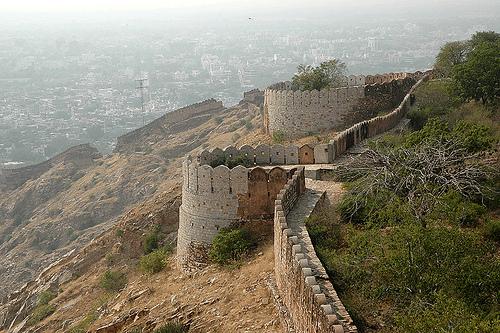 Nahargarh Fort
Nahargarh Fort
Nahargarh Fort stands on the edge of the Aravalli Hills, overlooking the pink city of Jaipur in the Indian state of Rajasthan. The view of the city from the fort is breath taking. Along with Amber Fort and Jaigarh Fort it formed a strong defence ring for the city. During the Sepoy revolt of 1857, Nahagarh served as a refuge for Europeans fleeing from the havoc created by mutineers in neighboring states. The word Nahargarh means the abode of tigers. Legends say that it was name after Prince Nahar whose spirit haunted the place and obstructed construction of the fort.
Built mainly in 1734 by Maharaja Sawai Jai Singh II, it is partially in ruins. It was extended in 1868. The rooms are linked by corridors and still have some delicate frescos. There are nine apartments for the nine queens the Maharaja had and all are well planned and decorated. Nahargarh is also called as the Hunting residence of Maharajas.
Amber Palace
The Amber Palace complex overlooking the artificial lake south of the town of Amber is one of the most popular tourist sites in the city, famous for its mixture of Hindu and Muslim architecture, and offering elephant rides from the town up to the palace courtyard. Although the structure is today known as Amber Fort, the complex was initially a Palace Complex within the Fort of Amber which is today known as Jaigarh fort.
Jaigarh Fort
The Jaigarh Fort on the hills above the Amber Palace complex offers stunning views of the foothills of the Aravalli range, as well as attractions such as immense underground water-storage tanks, a medieval canon foundry and an impressive collection of medieval cannons including the Jaivana which is reputed to be the world's largest cannon on wheels. Historically this was the original Amber Fort, although it became known as Jaigarh from the time of Sawai Jai Singh II onwards.
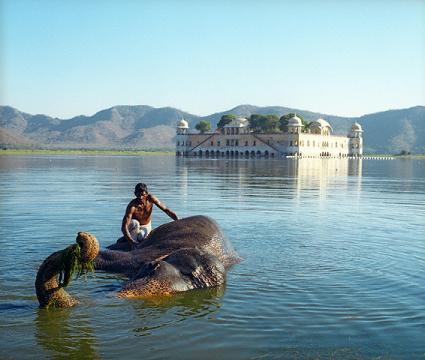
Jal Mahal
It is located in Jaipur India, which is the capital of the State of Rajasthan. It is on the way to Sisodia garden. The Rajput style "Water Palace" is located in the center of the Man Sarobar Lake. The lake is often dry in the summer but winter monsoons frequently turn it into a beautiful placid lake filled with water hyacinths.
Jantar Mantar
The Jantar Mantar is a collection of architectural astronomical instruments, built by Maharaja Jai Singh II at his then new capital of Jaipur between 1727 and 1733. It is modelled after the one that he had built for him at the then Mughal capital of Delhi. He had constructed a total of five such labs at different locations, including the ones at Delhi and Jaipur. The Jaipur observatory is the largest of these.
The name is derived from yantra, instrument, and mantra, for chanting; hence the 'the chanting instrument'. It is sometimes said to have been originally yantra mantra, mantra being translated as formula, although there is limited justification for this since in traditional spoken Jaipur language, the locals obfuscate the written 'Y' syllable as 'J'.
The observatory consists of fourteen major geometric devices for measuring time, predicting eclipses, tracking stars in their orbits, ascertaining the declinations of planets, and determining the celestial altitudes and related ephemerides. Each is a fixed and 'focused' tool. The Samrat Jantar, the largest instrument, is 90 feet high, its shadow carefully plotted to tell the time of day. Its face is angled at 27 degrees, the latitude of Jaipur. The Hindu chhatri (small domed cupola) on top is used as a platform for announcing eclipses and the arrival of monsoons.
Built of local stone and marble, each instrument carries an astronomical scale, generally marked on the marble inner lining; bronze tablets, all extraordinarily accurate, were also employed. Thoroughly restored in 1901, the Jantar Mantar was declared a national monument in 1948.
An excursion through Jai Singh's Jantar is the singular one of walking through solid geometry and encountering a collective weapons system designed to probe the heavens.
The instruments are in most cases huge structures. They are built on a large scale so that accuracy of readings can be obtained. The samrat yantra, for instance, which is a sundial, can be used to tell the time to an accuracy of about two seconds in Jaipur local time. Today the main purpose of the observatory is to function as a tourist attraction.
Major Yantras or instruments that you can watch moving clockwise are:
1. Small 'Samrat'
2. 'Dhruva'
3. 'Narivalya'
4. The Observer's Seat
5. Small 'Kranti'
6. 'Raj'
7. 'Unnathamsa'
8. 'Disha'
9. 'Dakshina'
10. Large 'Samrat'
11. 'Rashivalayas'
12. 'Jai Prakash'
13. Small 'Ram'
14. Large 'Ram Yantra'
15. 'Diganta'
16. Large 'Kranti'
Hawa Mahal
Hawa Mahal, or the "Palace of Winds", is a palace in Jaipur, India. It was built in 1799 by Maharaja Sawai Pratap Singh, and designed by Lal Chand Usta. It forms part of the City Palace and extends the Zenana or women's chambers, the chambers of the harem. Its original intention was to allow royal ladies to observe everyday life in the street below without being seen.
It has five stories and is constructed of red and pink sandstone, highlighted with white quakeee quick lime. The side facing the street outside the palace complex has 953 small windows, and the breeze (hawa) which circulates through these windows gives the palace its name, and keeps it cool even in hot months.
The entrance opens onto a courtyard with a double-storied building on three sides, and one on the eastern wing with three more stories, which is just one room wide. There are no stairs to reach the upper floors, only ramps.
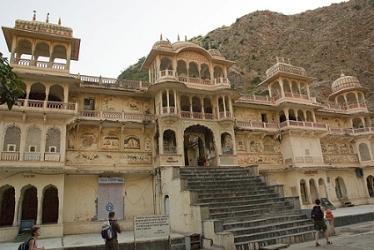 Galtaji
Galtaji
Galtaji is an ancient Hindu pilgrimage site situated 10 km from Jaipur in Indian state of Rajasthan on Jaipur-Agra highway near Sisodia Rani Ka Bagh .There are temples, pavilions, natural springs and holy 'kunds'.
It is believed that Saint Galav spent his life here and did meditation.
The main temple here is temple of Galtaji in pink stone and has a huge complex. The temple has a number of pavilions with rounded roofs, exquisitely carved pillars and painted walls. The temple is surrounded by natural springs and reservoirs that are considered holy .There are seven tanks here and the Galta Kund is considered the holiest. A large number of people take a holy bath in these tanks especially on Makar Sankranti.
There is another temple in complex and that is temple of Balaji. Yet another notable temple at Galta is Surya Temple dedicated to the Sun God built in the 18th century .
Govind Devji temple
Govind Devji Temple is one amongst the major tourist attractions of Jaipur. The Temple represents the royal past of Jaipur. The Temple is dedicated to Govind Devji (Other name of Lord Krishna). Govind Devji Temple of Jaipur is situated in the City Palace complex, between the Chandra Mahal and Badal Mahal. Govind Devji is the principal deity of Amber's Kachawaha Dynasty. In the earlier times, the idol of the lord used to reside in the temple of Vrindavan in Uttar Pradesh.
According to a legend, Govind Devji appeared in the dream of Raja Sawai Jai Singh and asked him to bring his idol from Vrindavan to Jaipur. As a consequence, Raja Sawai Jai Singh brought the idol and placed in the City Palace complex of Jaipur. After the sad demise of Jai Singh, many successors acquired the throne, but Raja Man Singh took the initiative to build the temple in 1890.
The beautiful image of Radha-Krishna doesn't let people to take off their eyes from the lovely view. Different 'Aartis' and 'Bhog' are offered to the deity at seven different times of the day. Every time, when the idols are revealed to the devotees, they are clothed in a different manner. The Devotees, who come here to get the glance or 'Darshan' of the deities, reverberates the temple with the pious phrase "Jai Govind".
A large number of tourists and devotees visit this temple of special importance. Janmashtmi, the birthday of Lord Krishna, is a special event and is celebrated with full enthusiasm. Govind Devji Temple is a sacred place of the Hindus. The Temple has also become a tourist attraction in the contemporary times.
Crystal Court
This is a state-of-the-art international level shopping arcade situated at Vaishali Nagar, a posh colony of Jaipur. The transformation of the global destination as a upwardly mobile citizens of a city is evident on the landmark shopping complex that can easily compete with any world class global mall anywhere in the world.
Crystal Mall
A similar shopping mall that enthralls the senses of even a member of the billionaire club. These spectacular new age edifices take the tourist destination also to a destination that is worth visiting to experience the satellite townships as a model of new age urbanization revolution of India.
 City Palace Museum
City Palace Museum
The City Palace was built by Maharaja Jai Singh II of the Kachhwaha clan of Rajputs, but a lot of changes and additions were made to the original structure by his successors.
The architecture of the City Palace is a synthesis of Rajasthani and Mughal styles. The Complex comprises of many structures, courtyards, gardens and buildings. There are many splendid small palaces and halls in the complex, such as the Chandra Mahal, Mubarak Mahal and Badal Mahal. There is also a famous temple called the Shri Govind Temple and a museum inside, named the City Palace Museum.
As one enters the first courtyard, one comes across the Mubarak Mahal, which was built in the 19th century by Maharaja Madho Singh II. Here is a splendid gateway, which leads to the Diwan-I-Khas (Hall of Private audience). It is an open hall, where there are two silver vessels on display, which are in the Guinness book of World Records! One can also check out the Diwan-I-Aam (Hall of Public Audience).
As one moves on, one sees the Chandra Mahal, which many consider being the highlight of the whole tour of City Palace. It has a lot of paintings, mirror work on walls, and floral decorations that make the Moon Palace truly magnificent.
It is a seven-storied Palace, where each level has a distinct name. The lower two levels have the Maharaja Sawai Man Singh II Museum, which has a large collection of 15th century weapons, carpets and rarities. There is also the Sukh Nivas or the 'Hall of Rest', which has the drawing and the dining area. On the fourth floor is the 'Shobha Nivas' or 'Hall of Beauty' which is decorated with mirrors all over and has gold leaf and mica decorations. The fifth floor is the 'Chavi Nivas' or the 'Hall of Images' and the sixth floor is known for the beautiful view it offers of the surrounding area. The uppermost floor is called the 'Mukut Mahal' or the 'Crown building'. When one moves forward to Badal Mahal from the Chandra Mahal, one comes to the Govind devji temple, which is also quite like the others, a must-see.
The City Palace does not only have a lot of historical significance but is also a reminder of the royal past. It stands as a symbol of the royal elegance and courtly splendor that is no longer visible. Perhaps, this is why people love coming to the City Palace in Jaipur, Rajasthan.
Ganesh Temple
In the middle of Jaipur rises a small hill Moti Dungri meaning pearl hill, because it looks hill a drop of pearl. An exotic palace is parched which is a replica of Scottish castle once occupied by Maharaja Madho Singh's son. From There on remained as a private property of the ruling family. In the recent past it served as a home for Rajmata Gaytri Devi and her estranged son Jagat Singh. The mere view of this castle is exotic enough. The highlight of this place is the famous and auspicious temple of Lord Ganesh, which is frequently visited by almost whole of Jaipur and people from outside.
It is built as a replica of the Scottish castle. However, it is the Ganesh Temple, which is most famous here. It is situated quite close to the Moti Doongri fort, which was converted to a small palace by Ram Singh II and Gayatri Devi.
Keeping in mind the secular nature of the country, the temple has three domes, which represent different approaches to religion. It is a beautiful white marble temple, which seems to glow at night. The architectural style in which the temple is built is a pleasing amalgamation of Western, Hindu and Muslim architectural traits.
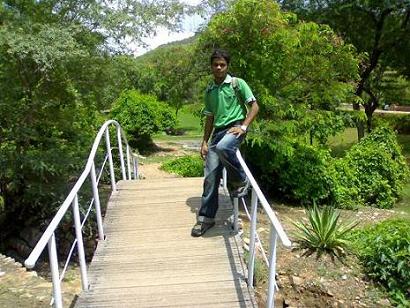 Kanak Ghati
Kanak Ghati
Kanak Ghati is a picturesque garden laid down in the Mughal style with lots of fountains and ponds. It has a complex of fine temples and gardens inside the colonnaded pavilion (1707) that has been restored recently by the Birlas. Kanak Vrindavan is an attractive spot both for tourists as well as locals who come for their share of outing on a picnic day.
Kanak Vrindavan Garden is nestled in the jungle-clad foothills of the Nahagarh Hills in the idyllic green oasis of Kanak Valley, a former elephant path fringed by the Aravalli Range. The sanctity and quietude of the Kanak Valley is illuminated by the historical references, which attribute the valley to be the sacred site for the performance of the Aswamedha Yagna.
Kanak Vrindavan Garden was christened by Raja Sawai Jai Singh, the versatile founder of Jaipur who was mesmerized by the garden's breathtaking beauty and found it similar to Lord Krishna's venerable sanctum at Vrindavan. The garden is a popular tourist spot for pilgrims during Rajasthan's celebrated Teej and Gangaur festivals. The celestial beauty of Kanak Vrindavan Garden is enhanced by the faint enchanting strains of hymns from the nearby shrines of Govind Deoji and Natawarji.
The garden, marked by beautifully tended landscaped lawns and replete with pretty fountains, sparkling and tranquil lakes, colorful is one of Jaipur's most popular picnic spots and site for film shootings. Kanak Vrindavan Garden sprawls across a massive expanse and houses an ornate beige stone temple with imposing marble columns and intricate lattice windows.
The garden offers a bird's eye view of the nearby picturesque Jal Mahal and the majestic trio of Nahargarh Fort, Jaigarh Fort and Amber Fort. The ripples of the cascading waterfalls, the sylvan lakes dotted with pink lotus buds and fringed by the Dhok and Kadamba groves have a magical charm. The pristine beauty of the wilderness is an ornithologist's dream since the garden houses a variegated range of migratory birds like kingfisher, spotted dove and Neel Kanth.
A trip to Jaipur remains incomplete without a visit to the historically significant Kanak Vrindavan Garden abounding in its panoramic rhapsodies.
Visiting Hours: 0800-1700 Hours for garden and 0800-1900 Hours for the temple
Albert Museum in Ramniwas Bagh
Ram Niwas Bagh was established by the founder keeping in mind the famine that had struck the city. Ram Niwas Bagh in Jaipur is a green patch in the midst of acres of barren desert. It is a garden established by Maharaja Ram Sigh in the 19th century. It was a famine relief project and also houses a zoo, a bird sanctuary, a museum and a sports complex.
Amidst the beautiful Ram Niwas Garden, surrounded by pools, fountains and rows of flowerbeds stands the exquisite Albert Hall, built on 1886 A.D. Designed by Colonel Sir Swinton Jacob who has crafted other Palaces of Rajasthan, built the Albert hall in honor of the King Edward VII visit to Jaipur, in Indo-Saracenic style.
Jawahar Circle
This is the biggest circular park in Asia developed on highway. The diameter of the circle is 452 m and the circumference measures 1420 m. This park was fully developed by JDA (Jaipur Development Authority), and is one of the favorite unwinding spot for the residents and visitors of the Pink City.
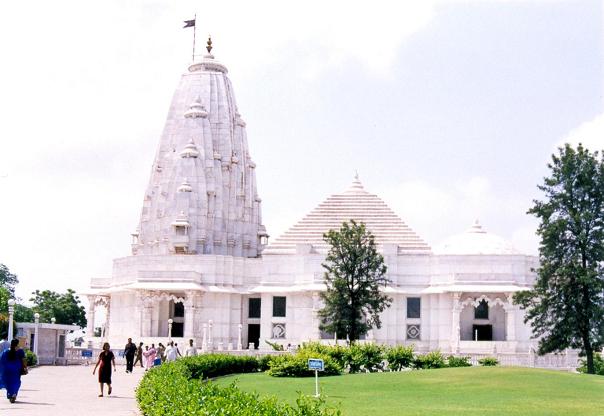 Birla Temple
Birla Temple
The Laxmi Narayan temple is located in the South of Jaipur, and was built by the Birla family, which is a major industrialist family of India. This is why; the temple is also called the 'Birla Mandir'. It is situated quite close to the Moti Doongri fort, which was converted to a small palace by Ram Singh II and Gayatri Devi.
Keeping in mind the secular nature of the country, the temple has three domes, which represent different approaches to religion. It is a beautiful white marble temple, which seems to glow at night.
The Birla Mandir in Jaipur attracts many tourists and devotees every year. The temple is very crowded during the festivals as Hindus come from all over the state and country to pay their respect to the Lord.
Ram Niwas Bagh
Ram Niwas Bagh was established by the founder keeping in mind the famine that had struck the city. Ram Niwas Bagh in Jaipur is a green patch in the midst of acres of barren desert. It is a garden established by Maharaja Ram Sigh in the 19th century. It was a famine relief project and also houses a zoo, a bird sanctuary, a museum and a sports complex.
Amidst the beautiful Ram Niwas Garden, surrounded by pools, fountains and rows of flowerbeds stands the exquisite Albert Hall, built on 1886 A.D. designed by Colonel Sir Swinton Jacob who has crafted other Palaces of Rajasthan, built the Albert hall in honor of the King Edward VII visit to Jaipur, in Indo-Saracenic style. The Albert Hall-fine example of Indo Saracenic style of architecture designed by Sir Swinton Jacob, was opened later with an exquisite collection of sculptures, paintings, decorative wares, natural history specimen, and Egyptian mummy and the celebrated Persian carpet.
Sisodia Rani Garden
It has tiered multilevel gardens with fountains, water channel and painted pavilions and suites of living rooms. There are many gardens in Jaipur and the most remarkable amongst them include Vidyadhar Garden, dedicated to the architect of the city, Sisodia Rani Ka Bagh, and the Kanak Vrindavan Valley.
Sisodia Rani-ka-Bagh is the largest and the most famous garden built by Sawai Jai Singh II for his Sisodia Queen. The garden is situated on the Jaipur -Agra highway in the southeast corner of the pink city. Sisodia Rani-ka-Bagh consists of multilevel gardens with fountains, watercourses and painted pavilions. The Sisodia Queen was the beautiful wife of Sawai Jai Singh's, who belongs to the city of Udaipur. The garden is located at a distance of about 10 km from Jaipur.
The Garden was built in and laid out in the Mughal style with fountains, water channels and many painted pavilions. During the royal times, the garden was a perfect place for the queen to enjoy the beautiful landscape, cool breeze and fresh air.
The Sisodia Rani ka Bagh displays the skill of human architectural excellence in consonance with the beauty of nature. The beautiful garden is replete with many murals and paintings that vividly depict the legends of Radha-Krishna. The garden was like a summer retreat for the royal families in the 18th and 19th century and serve as a tourist attraction now.
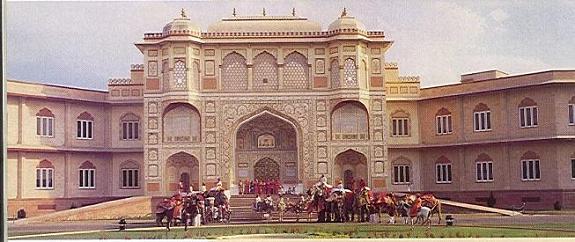 BM Birla Planetarium
BM Birla Planetarium
The Birla Planetarium is one of the leading landmarks in the pink city of Jaipur. It is located at the BM Birla Science & Technology Center, near Statue Circle. The Planetarium offers unique audio-visual educational and entertainment with its modern computerized projections system. For school groups concessions are available. The planetarium remains closed on last Wednesday of every month and visiting hours are 12.00 hrs to 19.00 hrs on all other days.
The planetarium helps to enhance knowledge of planets and cosmic functions and movements and on special occasions like on a special day when some rare phenomenon related to stars and planets are about to occur several shows are arranged and concessions are given so as to enable all to come and witness the phenomenon.
Equipped with modern computerized projection system, the planetarium offers unique audio-visual educational entertainment. A Science Museum is also a part of this one of the most modern planetarium in India. Owing to its central location in Jaipur, the Birla Planetarium is easily accessible to all its visitors.
Jain temple Sanganer, Jaipur
The ancient Shri Digamber Jain temple of Sanganer is just 16 km from Jaipur. Sanganer town situated 13-14 km south of the Jaipur City on National Highway No. 12, Kota - Jaipur Road. Shri Digamber Jain temple Sanghiji is a landmark site that is thronged by devotees and general visitors.
By Rail- Sanganer Railway Station is the nearest. In this temple the principal deity is that of the Lord Adinath (Rishabh Dev), the first tirthankar supposed to be 4000 years old.
The ancient Shri Digamber Jain temple of Sanganer has fine carvings that are comparable to the Dilwara temples of Mount Abu that are built in many phases. Last phase of this spectacular temple was completed in 10th century A.D., according to inscription of V.S. 1011 in one of the pylons (Toranas). It has sky-high 'shikharas' (spires) and the inner sanctum is a stone shrine with skyhigh eight Shikharas (Pinnacles). This temple is seven storied.
The whole of the temple is made of red stone with attractive images carved. The sight of the architecture of main gate reminds the architecture of famous Dilwara Temples of Mount Abu. In the midst of underground structure, there is located an ancient small temple guarded by the Yaksha (Devas). It is said that only a Balyati ascetic digamber saint can enter in it and bring out the idols of this underground temple for a limited period, which as decided previously. The idols thus brought out for viewing (Darshan) of devotees, must be placed back with in auspicious sign.
The beautiful nij-mandir (inner temple) is a stone shrine with three pinnacles. In the centre is an idol of Parshwanath with 7 serpent hoods. Surrounding it are carvings of lotuses, creepers and elephants pouring water from pitchers held in their trunks. But the main idol is that of Adinath, installed in the shrine behind this.
In addition to its exquisite Jain temples, Sanganer is an important centre for crafts and hand-printed textiles that gives it an international recognition.
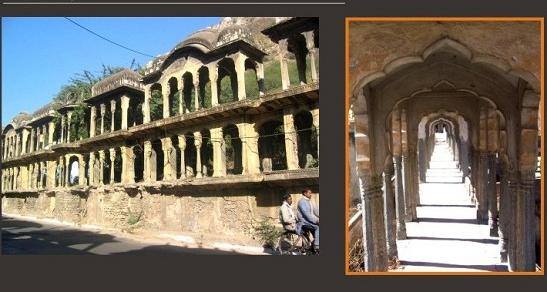 Ghati ki Guni
Ghati ki Guni
In the 18th and 19th centuries, the royals and the nobles laid out summer gardens at Ghati ki guni, a valley at beginning of the Jaipur-Agra road which traps the breezes and wafts it through pleasantly.
Old City
Once a settlement of nobles, craftsmen and common folks, the city of Amer is now in ruins. The remnants of its rich past are the beautifully carved and planned Jagat Shiromani Temple, a Krishna temple associated with Meerabai, an ancient temple of Narsinghji and a magnificent step-well, Panna Mian-ka-kund.
Swargasuli (Isar Lat)
Swargasuli also known as Isar Lat meaning the heaven piercing minaret was built in 1749. It is located at the junction of the Tripolia Bazar and the Gangori Bazaar. Isar Lat or Swargasuli is a seven storey minaret designed in archetypal Rajasthani lattice work.
Swargasuli was built to commemorate the difficult victory of Ishwari Singh over the armies of Mewar and Marathas. The Marathas and Mewar armies were supporting Madho Singh's claim to be the ruler. Ishwari Singh after winning the throne began his rule. However, he could not fight the strong Maratha opposition for a very long time and decided to kill himself. After suicide he was not cremated at Gaitor, the usual royal crematorium where all rulers are cremated.
The seven storey minaret was built on the lines of the Qutub Minar and Kirti Stambha of Chittaurgarh. The walls are designed in intricate lattice work which helps to provide air and light to the entire building. The highest point of the minaret is also accessible.
From the lofty minaret of the Isar Lat or Swargasuli, you can get the breathtaking views of the Jaipur City. From the upper limits of the Swargasuli, you can see the multitude of buildings and havelis of the pink city. It is a marvelous sight which the travelers don't wish to miss.
EXCURSIONS
Samode
The Nathawat family of Samode served as prime ministers in Jaipur court, and their four-century-old fortified residence some 40 km from Jaipur is able to exibit the good taste learned at royal palaces in a more restrained space. The Durbar hall at Samode Palace is one of the most beautifully painted chambers in Rajasthan. Close by is the samode bagh, the garden pavilion with charming water channels and ancient trees. In Jaipur itself, the family built itself a townhouse, samode haveli, which typifies the style of architechture then in vogue, including accessible public spaces, especially for the women of the family. The paintings at the Haveli are every bit as excellent as at the Palace, if a little less profuse. All three properties are hotels.
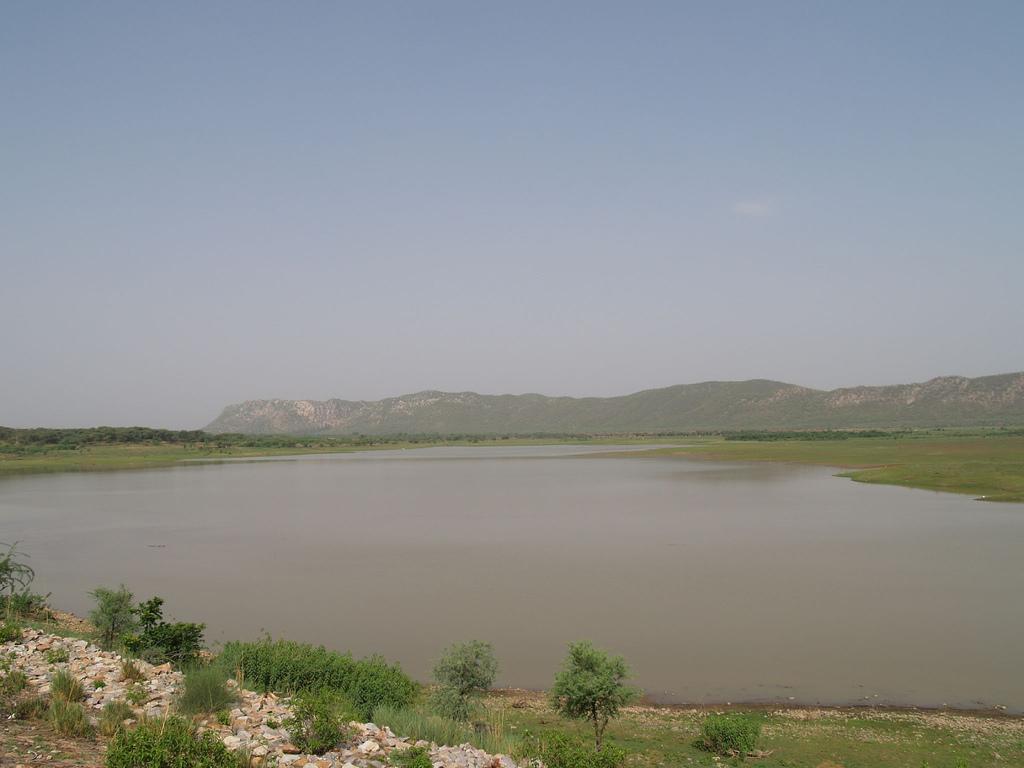 Ramgarh Lake
Ramgarh Lake
32 km north-east, it is a huge artificial lake created by constructing a high bund amidst tree covered hills where the citizens throng in a large number for picnic during the rainy season. This lake has been shaped by raising a high bund amidst the hills covered with trees. In the rainy season, when the lake gets inundated with water, people come in large numbers for a picnic. Ramgarh Lake is around 4 kms in length and 2 kms in width, big enough to please the crowds.
Ramgarh is a place of royal past that boasts of a majestic hunting lodge. However, the lodge has been converted into a gateway hotel with the changing times. The wrecks of the ancient fort still remind one of its old days when the Kachhawah's first settled here before moving on to Amer. Even today, the temple of Jamwa Mata attracts the tourists for its magnificent architecture. Every year, people from far and near come to visit the place. The temple of Jamwa Mata and the ruins of the old fort still reminds of its hoary antiquity.
Bagru
Bagru is a small village, located at a distance of 30 kms from Jaipur, on Jaipur-Ajmer Road. The village town of Bagru is not popular for any palace or fort, but for its typical wooden prints. These prints of Bagru are acclaimed all over India and are particularly known as Bagru prints. The Prints of Bagru, unlike other prints, involve a different kind of printing. The unique method for printing employs wooden block in it. In the process, the desired design is engraved on the wooden block first and then the carved block is used for replicating the design in the preferred color on the fabric.
Chippa Mohalla (printer's quarter) is the area for those, who are interested in textile printing. One can walk into the quarter, where people are always engrossed with dyes and blocks. The three-centuries-old tradition of block printing is kept alive with the efforts of Bagru artisans. Keeping the convention, these artisans smear the cloth with Fuller's earth got from the riverside and then dip it in turmeric water to get the habitual cream color background. After that, they stamp the cloth with beautiful designs using natural dyes of earthly shades.
As a matter of fact, Bagru prints are more famous for their exceptional quality of being eco-friendly. Even today, artisans use traditional vegetable dyes for printing the cloth. Like, the color blue is made from indigo, greens out of indigo mixed with pomegranate, red from madder root and yellow from turmeric. Usually Bagru prints have ethnic floral patterns in natural colors. Bagru prints form the essential part of the block printing industry of Rajasthan. The village fabricates some of the fabulous bed covers and other materials.
The brilliance of the craft has located this small village of Bagru near Jaipur on the map of International fashion. Rajasthan block printing recognition gets complete, with the amalgamation of Bagru printing in it. The village of Bagru will be definitely a treat for craft lovers and one must visit the place to acknowledge the tradition of former centuries.
Bairath
Bairath is a place of historical significance, located at a distance of 86 kms from Jaipur, on Shahpura-Alwar Road. Bairath is said to have existed from the times of Mahabharata. In that period, Bairath was known as Virata Nagar. It used to be the capital of Abhimanyu's (Arjuna's son) father-in-law. After getting exile, Pandavas are believed to spend one year in Bairath. Excavations expose the fact that Bairath used to be the part of Mauryan Empire and thrived as a Buddhist establishment.
Bairath still has the periodical remnants of Mauryan, Mughal and Rajput structural designs. It is also acknowledged for the ruins of a circular Buddhist temple, the earliest structural temple in India. The Mughal Emperor, Akbar, built a mint in Bairath. A beautiful Mughal garden too occupies the lands of Bairath. Jahangir, son of Akbar, constructed a significant monument with painted 'chattris'. All these archeological revelations are the cursors to the ancient Bairath.
Other attractions at Bairath are Bhim-Ki-Dungri and Bijak-ki-Pahari. Bhim-ki-Dungri is also known as Pandu Hill. This is low rocky hill with a cave that is believed to be Bhim's (One of Pandava brothers) abode. The other interesting place is Bijak-ki-Pahari, which is a grey granite hill with remnants of two Buddhist monasteries. These monasteries are supposed to have existed when Huen Tsang (the Chinese Traveler) came to visit India in 634 A.D.
Bairath is also known for Banganga Fair which is celebrated annually near the town. This event is observed on the full moon day of Vaishakh (April- May). Bairath forms a major part of excursion from Jaipur. Due to its historical significance, it is visited by large number of people every year.
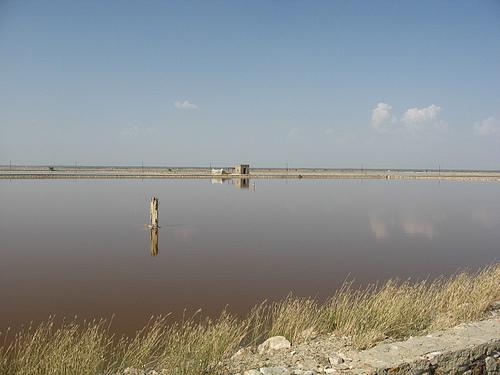 Sambhar
Sambhar
Famous for the country's largest inland salt lake, it is an ancient city. It was the first capital of the Chauhan dynasty. Also known as Sakambhari, as it was founded near the temple of Goddess Sakambhari, the place is also known for its holy Devyani tank, the palace and the nearby Naliasar, where third century onwards sculptures and terracotta artifacts were found in excavation. This place is situated on the Sambhar-Naraina Road. Sambhar lake is also popular for the illusion of water ( mirage ) during noon.Sambhar is a small town, located at a distance of 60kms in the west of Jaipur, on Jaipur-Ajmer Highway. Sambhar is famous for the largest saline lake in India. Due to this fact, Sambhar is also known as Salt Lake City. Literally, Sambhar means salt and the lake has been providing salt for over a thousand years. Various rulers of Jaipur and Jodhpur including Sindhias, Rajputs, Marathas and Mughals have owned the lake in their ruling periods. In 1870, it was leased to the British.
After independence, the lake was taken over by the government. In the present day, it is managed by Sambhar Salts Limited, a joint venture of Hindustan Salts and the Government of Rajasthan. Sambhar Lake elongates to the length of 22.5 kms. The lake is fed by several seasonal freshwater streams, two of the major ones being the rivers Mendha and Rupangarh. The vast lake has been divided into two sections by a 5-km long stone dam. On the eastern side of the dam, there are reservoirs for salt extraction where salt has been farmed for a thousand years.
To the eastern part of the dam, you will find a rail trolley system that was originally developed by the British to get across the dam and to access various outlying points in the salt works. On the sand-smothered lanes on the shore of the Lake, you will see reddish-pink office buildings of Sambhar Salts Ltd. You can also visit the salt laboratory and the salt museum on the terrain.
Sambhar Lake is a place where horizons stretch to perpetuity, where water and sky merge in a shimmer of gossamer blue. The waters here are glacially still, edged with a glittering frost of salt. Sambhar has been classified as a Ramsar site (recognized wetland of international importance) since the wetland is a residence for thousands of flamingos and other birds that migrate from northern Asia in winters.
For bird-lovers, this is the best place to explore. In fact, the lure of Flamingos brings tourists to visit this salty lake. Myriad tall and dainty birds with their ballerina tutus come here to enjoy the delicious spirulina algae that thrive when the water reaches a medium degree of salinity. You can spot other birds too like pelicans, Storks, sandpipers, redshanks, black-winged stilts, coots, and shovelers those float in a relaxing mood over the tranquil water body.
There are many anecdotes regarding the existence of the lake. According to one reference in the epic Mahabharata, Raja Yayati, emperor of Bharatvarsh (India) and a descendant of Lord Brahma the Creator, married Devyani, daughter of Shukracharya (the guru of demons) who lived by the Sambhar lake. As per another legend, the Goddess Shakambhari bestowed the lake for the benefit of people around 2,500 years ago. A small sparkling white temple in her honor stands in a rocky outcrop on the southern bank of Sambhar Lake.
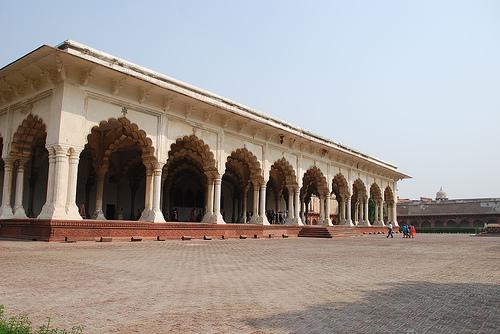 Abhaneri
Abhaneri
Abhaneri is a small town village, situated at a distance of 95 km from Jaipur, on Jaipur-Agra road. The place is popular for the amazing 'Baoris' (step wells) and Harshat Mata Temple. The village of Abhaneri is believed to be established by the King Raja Chand. Originally Abhaneri was named as Abha Nagri, which means the city of brightness, but due to mispronunciation of the term, it is changed to the present name.
In the present day, this city of brightness is in ruins; still it attracts tourists from across the globe. Abhaneri is prominent for 'Baoris', which are the unique invention of the natives for harvesting rain water. Amongst the other step wells, Chand Baori is the most popular one. This colossal step well is located in front of the Harshat Mata Temple. Chand Baori is one of India's deepest and largest step wells. The huge tank with delicate carvings is certainly delightful to the eyes.
Step wells are the unique concept of India. These big tanks were used as cool places of resort and water reservoir in parched days. It was a ritual to wash hands and feet before visiting the temple. Adjoining the Chand Baori, there is a temple, dedicated to Harshat Mata. This temple serves as the other tourist attraction of Abhaneri. Raised during the 10th century, the wrecks of the temple still boast of the architectural and sculptural styles of ancient India.
Harshat Mata is considered to be the goddess of joy and happiness. As per the beliefs, the goddess is always cheerful, who imparts her joy and happiness to the whole village. The temple is worth visiting for its amazing architecture from the medieval India. Abhaneri has a glorious past and this hoary magnetism of the place, attracts tourists to its threshold, from all over the world. Two Jain temples were built at a later period.
|

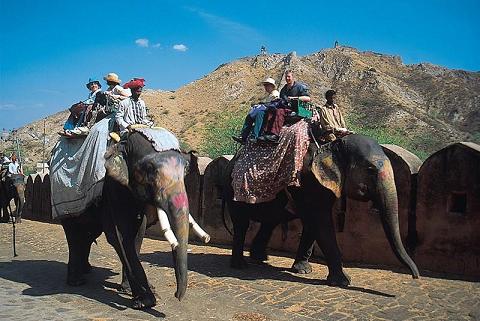
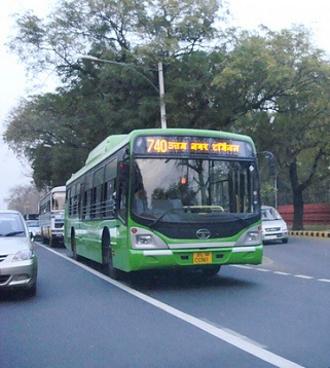
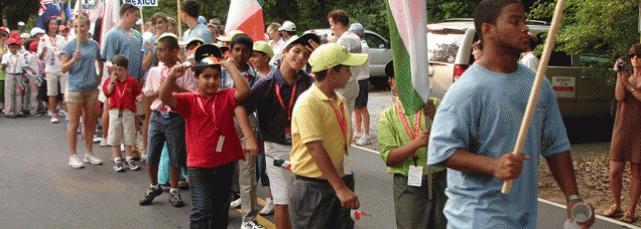
 Nahargarh Fort
Nahargarh Fort
 Galtaji
Galtaji  City Palace Museum
City Palace Museum  Kanak Ghati
Kanak Ghati  Birla Temple
Birla Temple BM Birla Planetarium
BM Birla Planetarium  Ghati ki Guni
Ghati ki Guni  Ramgarh Lake
Ramgarh Lake  Sambhar
Sambhar  Abhaneri
Abhaneri